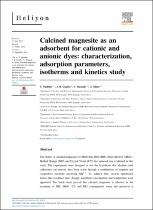 ResearchSpace
ResearchSpace
Calcined magnesite as an adsorbent for cationic and anionic dyes: characterization, adsorption parameters, isotherms and kinetics study
JavaScript is disabled for your browser. Some features of this site may not work without it.
- ResearchSpace
- →
- Research Publications/Outputs
- →
- Journal Articles
- →
- View Item
| dc.contributor.author |
Ngulube, T

|
|
| dc.contributor.author |
Gumbo, JR

|
|
| dc.contributor.author |
Masindi, Vhahangwele

|
|
| dc.contributor.author |
Maity, Arjun

|
|
| dc.date.accessioned | 2019-02-27T09:47:44Z | |
| dc.date.available | 2019-02-27T09:47:44Z | |
| dc.date.issued | 2018-10 | |
| dc.identifier.citation | Ngulube, T. et al. 2018. Calcined magnesite as an adsorbent for cationic and anionic dyes: characterization, adsorption parameters, isotherms and kinetics study. Heliyon, October 2018: doi: 10.1016/j.heliyon.2018.e00838 | en_US |
| dc.identifier.issn | 2405-8440 | |
| dc.identifier.uri | https://doi.org/10.1016/j.heliyon.2018.e00838 | |
| dc.identifier.uri | https://www.heliyon.com/article/e00838/ | |
| dc.identifier.uri | http://hdl.handle.net/10204/10730 | |
| dc.description | Copyright: 2018 The Authors. Published by Elsevier Ltd. This is an open access article under the CC BY license | en_US |
| dc.description.abstract | The ability of calcined magnesite for Methylene Blue (MB), Direct Red 81 (DR81), Methyl Orange (MO) and Crystal Violet (CV) dye removal was evaluated in this study. The experiments were designed to test the hypothesis that alkaline earth carbonates can remove dyes from water through a combination of sorption and coagulative reactions involving Mg(sup)2+. To achieve that, several operational factors like residence time, dosage, adsorbent concentration and temperature were appraised. The batch study proved that calcined magnesite is effective in the treatment of MB, DR81, CV and MO contaminated water and moreover it performed well in terms of color removal. The adsorption equilibrium data were analysed by the Langmuir, Freundlich, Dubinine-Radushkevich and Temkin isotherm models, and the Dubinine-Radushkevich and Temkin models were found to be the most appropriate fit to MB and MO dyes respectively. The adsorption kinetics process primarily followed the Elovich and Pseudo-second order model, a possible indication that chemisorption was the rate limiting step during the dye uptake process. With the adsorptionedesorption cycle repeated four times, the calcined magnesite regeneration efficiency for DR81 and MO loaded dyes remained very high. According to the results of this study, it can be concluded that calcined magnesite can be used effectively for the adsorption of MB, DR81, CV and MO from wastewater. | en_US |
| dc.language.iso | en | en_US |
| dc.publisher | Elsevier | en_US |
| dc.relation.ispartofseries | Worklist;22075 | |
| dc.subject | Environmental science | en_US |
| dc.subject | Theoretical chemistry | en_US |
| dc.subject | Physical chemistry | en_US |
| dc.subject | Materials chemistry | en_US |
| dc.subject | Analytical chemistry | en_US |
| dc.title | Calcined magnesite as an adsorbent for cationic and anionic dyes: characterization, adsorption parameters, isotherms and kinetics study | en_US |
| dc.type | Article | en_US |
| dc.identifier.apacitation | Ngulube, T., Gumbo, J., Masindi, V., & Maity, A. (2018). Calcined magnesite as an adsorbent for cationic and anionic dyes: characterization, adsorption parameters, isotherms and kinetics study. http://hdl.handle.net/10204/10730 | en_ZA |
| dc.identifier.chicagocitation | Ngulube, T, JR Gumbo, Vhahangwele Masindi, and Arjun Maity "Calcined magnesite as an adsorbent for cationic and anionic dyes: characterization, adsorption parameters, isotherms and kinetics study." (2018) http://hdl.handle.net/10204/10730 | en_ZA |
| dc.identifier.vancouvercitation | Ngulube T, Gumbo J, Masindi V, Maity A. Calcined magnesite as an adsorbent for cationic and anionic dyes: characterization, adsorption parameters, isotherms and kinetics study. 2018; http://hdl.handle.net/10204/10730. | en_ZA |
| dc.identifier.ris | TY - Article AU - Ngulube, T AU - Gumbo, JR AU - Masindi, Vhahangwele AU - Maity, Arjun AB - The ability of calcined magnesite for Methylene Blue (MB), Direct Red 81 (DR81), Methyl Orange (MO) and Crystal Violet (CV) dye removal was evaluated in this study. The experiments were designed to test the hypothesis that alkaline earth carbonates can remove dyes from water through a combination of sorption and coagulative reactions involving Mg(sup)2+. To achieve that, several operational factors like residence time, dosage, adsorbent concentration and temperature were appraised. The batch study proved that calcined magnesite is effective in the treatment of MB, DR81, CV and MO contaminated water and moreover it performed well in terms of color removal. The adsorption equilibrium data were analysed by the Langmuir, Freundlich, Dubinine-Radushkevich and Temkin isotherm models, and the Dubinine-Radushkevich and Temkin models were found to be the most appropriate fit to MB and MO dyes respectively. The adsorption kinetics process primarily followed the Elovich and Pseudo-second order model, a possible indication that chemisorption was the rate limiting step during the dye uptake process. With the adsorptionedesorption cycle repeated four times, the calcined magnesite regeneration efficiency for DR81 and MO loaded dyes remained very high. According to the results of this study, it can be concluded that calcined magnesite can be used effectively for the adsorption of MB, DR81, CV and MO from wastewater. DA - 2018-10 DB - ResearchSpace DP - CSIR KW - Environmental science KW - Theoretical chemistry KW - Physical chemistry KW - Materials chemistry KW - Analytical chemistry LK - https://researchspace.csir.co.za PY - 2018 SM - 2405-8440 T1 - Calcined magnesite as an adsorbent for cationic and anionic dyes: characterization, adsorption parameters, isotherms and kinetics study TI - Calcined magnesite as an adsorbent for cationic and anionic dyes: characterization, adsorption parameters, isotherms and kinetics study UR - http://hdl.handle.net/10204/10730 ER - | en_ZA |





